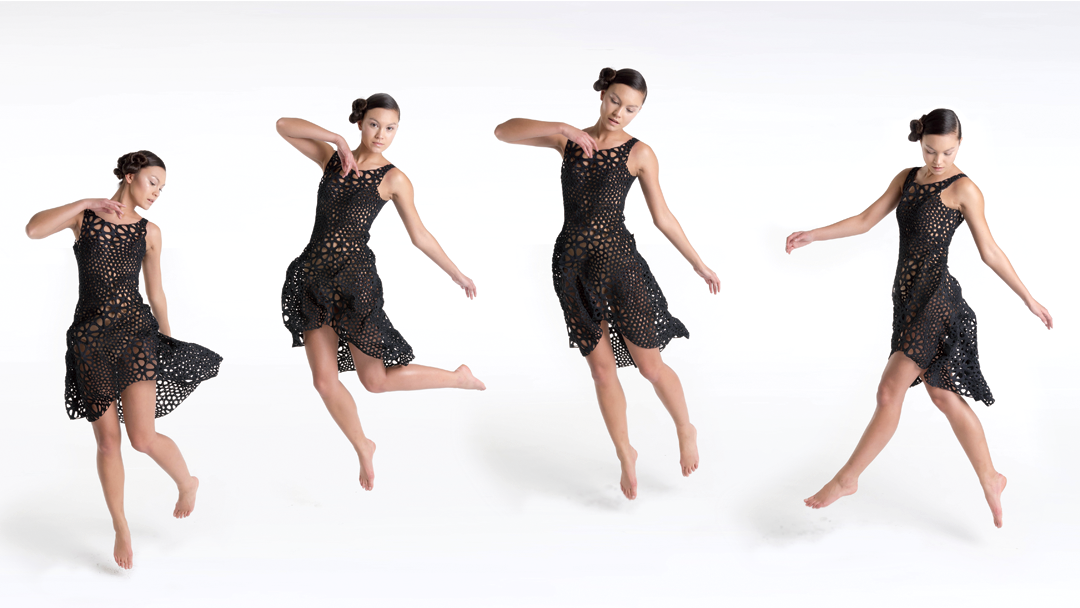
Category : PRODUCTS
By nervous system(United States)

Composed of thousands of unique interlocking components, each dress is 3D printed as a single folded piece and requires no assembly. The Kinematics Dress represents a new approach to manufacturing which tightly integrates design, simulation, and digital fabrication to create complex, customized products.
Bodies are 3-dimensional but clothing is traditionally made from flat material that is cut and painstakingly pieced together. In contrast, Kinematics garments are created in 3D, directly from body scans and require absolutely no assembly. We employ a smart folding strategy to compress Kinematics garments into a smaller form for efficient fabrication. By folding the garments prior to printing them, we can make complex structures larger than a 3D printer that unfold into their intended shape.
The custom-fit dress is an intricately patterned structure of thousands unique triangular panels interconnected by hinges, all 3D printed as a single piece in nylon. While each component is rigid, in aggregate, they behave as a continuous fabric allowing the dress to flexibly conform and fluidly flow in response to body movement. Unlike traditional fabric, this textile is not uniform; it varies in rigidity, drape, flex, porosity and pattern through space. The entire piece is customizable, from fit and style to flexibility and pattern, with Kinematics Cloth our app for clothing.
http://n-e-r-v-o-u-s.com/projects/sets/kinematics-dress/
The dresses are 3D-printed using Selective Laser Sintering in nylon. They are printed as a single piece in a folded configuration and after depowdering unfold into a fully wearable garment with no assembly.
Hiroya Tanaka
Hiroya Tanaka
In the field of digital fabrication research, research is being conducted into the production methods and design of objects that move or change shape after being printed, and this is called 4D printing.
This project is indeed a pioneer of this field and demonstrates the possibilities. What’s more, the entrants have overcome the size limits of the 3D printer by developing their own original technology that allows them to print the dress in its folded state and then they unfolding it once it is printed so that the item can be printed larger than the 3D printer itself. It will be firms like Nervous System, which is made up of a small team of both R&D tech specialists and designers, that will go on to lead the Fab movement.
Quake Hsu
Quake Hsu
While we say 3d printing clothes, we often think about those bulky and polygonal armors or some sculptural pieces stitched on the fabric. Unlike these old ideas, ‘Kinematics Dress’ is composed of hundreds if not thousands of precisely programed micro-elements. The adjustability of its meshed structure make the dress perfectly fit with the body shape and also give the dressed person flexibility to move. The combination of precisely 3d scanning and 3d printing makes ‘Kinematics Dress’ possibly even better than traditional dress in terms of fitting and customization. The technology on ‘Kinematics Dress’ can radically change the work method and design approach of fashion designers. I can see ‘Kinematics Dress’ may lead a revolution of textile industry. The same technology can also potentially be applied to other fields while we want a structure capable to adjust according to different form. The possibility of ‘Kinematics Dress’ is infinite.
Luke Yeung
Luke Yeung
With the Kinematics Dress, the designers have developed a piece of clothing that is extremely wearable on the body. The overall material is soft and pliable yet is made from rigid modules. We were astonished by the sophistication in the design and fabrication process - from the parametrically controlled module-sizing to the integrated hinge detailing joining every piece together. While it may not be a revolutionary game-changer, the Kinematics Dress is a major advance in 3D printing in fashion and marks a giant step in how the design industry is embracing technologies in fabrication in significant ways.
Yukiko Shikata
Yukiko Shikata
A form made to envelop the body, organic lines and an elegant silhouette that flows gracefully with the body’s every move—it’s the dress itself that initially captures your attention. In terms of Fab, the idea of creating and printing the dress in its folded up state using a computer, and then unfolding it to its intended size, which is bigger than a 3D printer, is just ingenious. This bottom-up approach has the potential to be applied to anything from dresses to architecture, and makes me envision a future where we use Fab to create clothes that fit like a second skin. The product was selected as it is created by a design studio that produces products with an outstanding quality and also offers labs/workshops, but it was also chosen because the entry paves the way for an innovative new field of design that draws on art, science and technology.
Seiichi Saito
Seiichi Saito
This dress is not like other 3D printer-made dresses that have ‘prototype’ written all over them, but its structure, materials and the product itself are all made possible thanks to the 3D printer. I think that the combination of the detailed interlocking structure, the polygonal design, its functionality, material and design quality are boast immense beauty and efficiency. I am looking forward to seeing how this dress will act as a catalyst for further advancements in this field.
Luki Huber
Luki Huber
The idea of folding a large piece onto itself, in order to make it fit in the limited space of a 3D printer, justifies this Grand prize and breaks new ground for this type of technology.
Congratulations.

